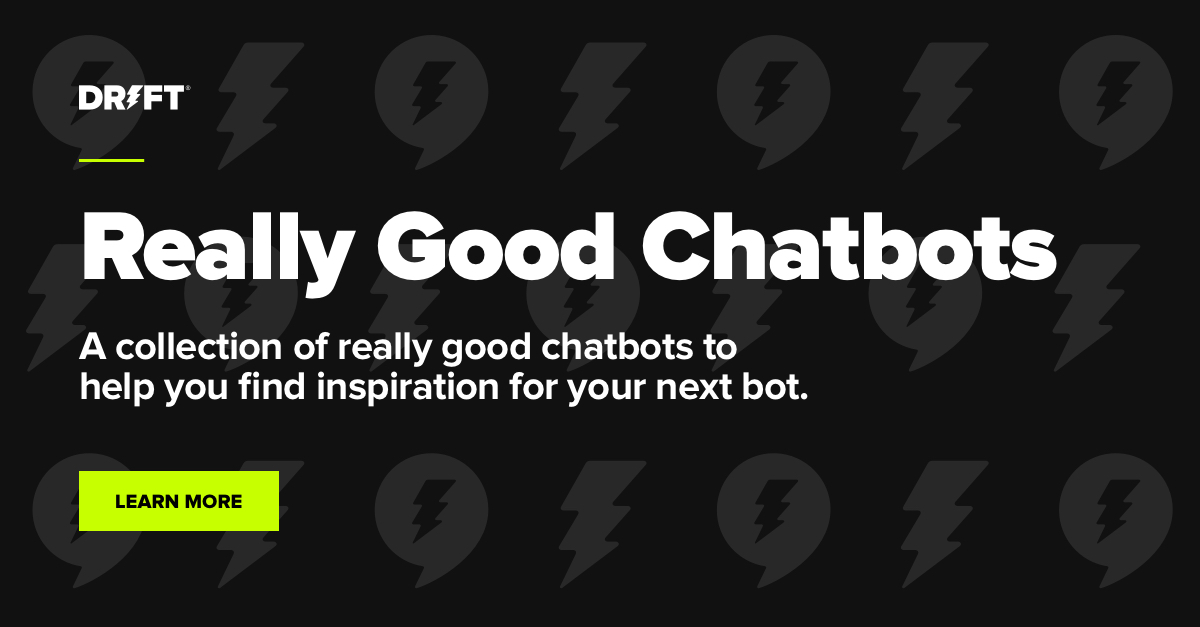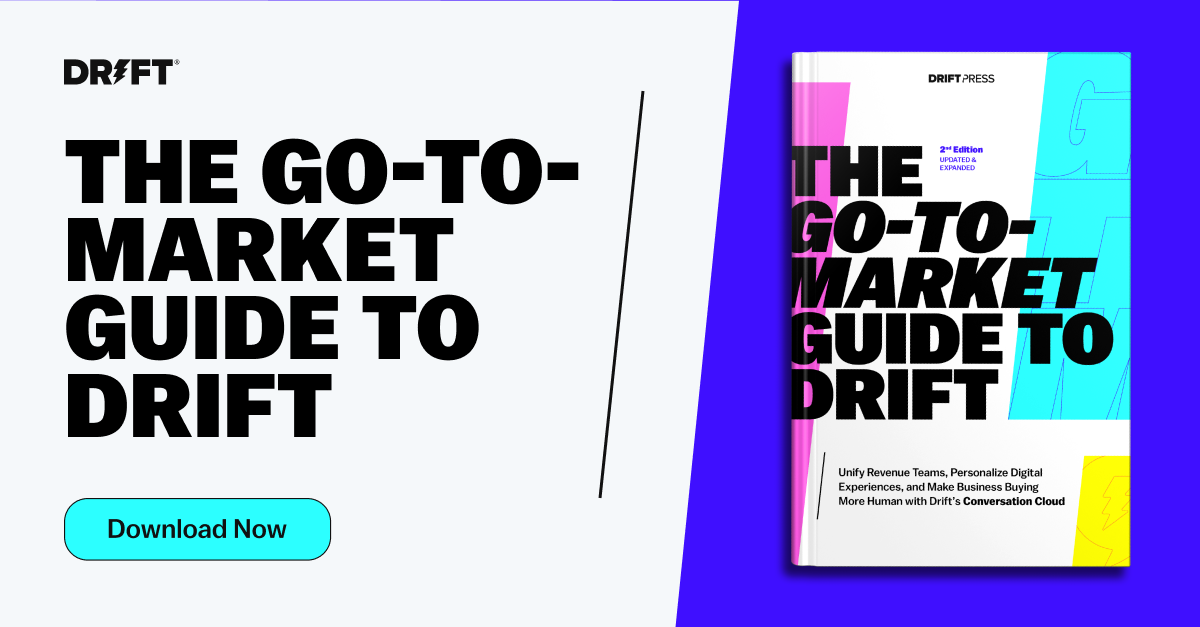I’ve been building chatbots at Drift for about three years now.
Along the way, I’ve tried designing a lot of different chatbots and Conversational Marketing strategies. Some worked great. Others…well, let’s chalk them up to learning experiences.
Overall, the biggest lesson I’ve learned is the importance of creating a Conversational Marketing strategy across your website, using bots that are engaging, personalized, and offer a great buying experience to your customer.
But all that learning is for nothing if I don’t share it, right? So I’ve put together a list of the 10 most tried-and-true bots I recommend everyone steals for their website.
Let’s get right into it.
P.S. We’ve put together a page to showcase the best chatbots being built by today’s Conversational Marketing and Sales leaders. Find them at our revamped Chatbot Examples page.
1. The Engage All Playbook
Whether you are brand new to building a chatbot or a chatbot aficionado, your Engage All playbook is one that you will keep coming back to, refining, and A/B testing.
Why? The Engage All playbook is the core of your playbook strategy. It’s your go-to use case, and we recommend all customers start here.
The Engage All playbook fires when a visitor doesn’t trigger a more targeted, higher-priority experience, such as a visitor on the pricing page or someone whose been retargeted.
This means the playbook will catch traffic across your whole website, giving all site visitors the opportunity to start a conversation.
Check out the video below from our 2021 Playbook Basics Certification which walks you through how to build your own Engage All playbook.
Now, let’s check out a real-life Engage All playbook from Gong pulled from our website, Really Good Chatbots.
Breaking It Down
What makes this Engage All playbook a really good bot? Let’s break it down using our Conversational Framework, which has three parts: Engage, Understand, and Recommend.
Engage
Gong engages the website visitor with a cheeky hook that draws the site visitor in.
Understand
Once engaged, the bot asks the site visitor a few follow-up questions to see why they are on the site, how the bot can best guide them in the right direction, as well as seeing if Gong is the right fit for them.
Recommend
Site visitors who are a good fit for Gong are recommended to chat with sales or book a meeting. Those who aren’t ready to book a meeting or need more information are guided towards best practice content.
Check out this blog to read more about our Conversational Framework and what makes a chatbot really good.
2. The Pricing Page Playbook
Let’s face it. Pricing pages on B2B websites can be really confusing.
There may be different tiers for pricing or language the buyer isn’t familiar with, and some pricing pages may not have prices listed at all.
Enter: the Pricing Page playbook.
The Pricing Page bot allows you to connect instantly with visitors while they have high intent to purchase.
Check out this example from PTC.
Breaking It Down
Engage
When a site visitor lands on a pricing page, there are likely many questions they will have as they navigate the page. PTC engages the buyer on this page by asking if there are questions they can help with.
Understand
The bot understands what the site visitor is looking for and provides options for those with specific questions and those just browsing.
Recommend
PTC then recommends their team follow up with interested site visitors and provides more information for those not interested in a sales follow-up.
3. The Fastlane Playbook
Conversational Marketing is all about removing friction from the buying experience. That’s why at Drift we set out on a #noforms mission. We decided to remove every single form from our website and replace them with chat.
A lot of companies adopted our mission and replaced their forms with chat too.
But we know not everyone can go from a world with forms to a world without forms right away.
That’s where the Fastlane playbook comes in.
With Fastlane, customers don’t have to give up their forms. Instead, they can turn their static forms into conversational forms. So, when a qualified buyer fills out a form, they can chat with sales instantly or book a future meeting without ever leaving the website.
Check out this real-world example from our customer, Tenable.
Breaking It Down
Engage
This Fastlane playbook appears once someone has completed the form and offers the site visitor a fast track to their sales team.
Understand
The bot goes on to ask if the site visitor wants to chat now, book a meeting, or is all set. Since the site visitor has already filled out the form, the bot doesn’t need to ask any qualifying questions.
Recommend
The bot then drops a calendar or routes in a sales rep so the site visitor can connect with the team right away.
4. The Blog Playbook
Want an easy way to increase your subscribers or engagement on your blog? Create a Blog playbook.
The Blog playbook is a great way to engage your website visitors while they are reading your blog. Through a regular bot or a DriftLink bot, use the Blog playbook to invite your readers to subscribe to your newsletter or recommend new content — without having to leave the page and go through a form.
Here’s an example from Lessonly’s blog:
Breaking It Down
Engage
Witty and cheeky — this hook engages the site visitor with a promise to delight them and find them the resource they need.
Understand
The bot goes on to understand what kind of resource the site visitor is looking for.
Recommend
Finally, the bot recommends a 15-minute demo with the Lessonly team, promising to show what Lessonly can do for them.
5. The Skip the Form Playbook
If you’ve gotten to this point in the blog (thanks for sticking around, friend) you know that the best Conversational Marketing examples are the ones that remove friction.
And the biggest point of friction in the B2B buying process? Forms.
Instead of making your high-intent site visitors fill out a form, offer them a Skip the Form playbook.
A Skip the Form playbook gives your visitors a faster alternative to a form, allowing them to connect with a salesperson ASAP. Use this bot on your “contact us,” “request a demo,” or other form pages to improve conversions and have more conversations.
Here’s a Skip the Form example from Qualtrics.
Breaking It Down
Engage
The bot is direct and asks the visitor if they would rather speak to a human than fill out the form.
Understand
Once the visitor has expressed interest in skipping the form, the bot offers that option while also routing in a sales rep or alerting a known account owner.
Recommend
The primary call to action (CTA) is to book time with the sales team, but there are options for those who are not yet ready to have that conversation.
6. The Conversational Content Playbook
We all know an effective content strategy is important. But what’s even more important is leveraging that content to create conversations.
Now, imagine if you could start a conversation with someone who’s reading a PDF on their desktop.
That’s where Conversational Content comes into play.
Conversational Content helps you start conversations with your ideal buyers while they’re reading your content.
Curious to see a Conversational Content example? Here’s one from Wake Forest University.
Breaking It Down
Engage
The hook acknowledges the site visitor’s interest in learning about graduate programs and engages the site visitor by offering to find the right graduate program for them.
Understand
The bot goes on to tell the site visitor they will be asking a series of questions to determine if they are eligible for the offer outlined in the hook. It then asks relevant questions to the site visitor to determine the best recommendation.
Recommend
After determining eligibility for their offer, Wake Forest recommends a meeting with their team.
7. The Persona Targeting Playbook
Many people visit your website every day: people with different titles, across industries, from large companies to small businesses. Using Drift Intel, you can create playbooks that are personalized to a specific persona.
Check out this example from Brandwatch, targeting website visitors who are in the technology industry.
Breaking It Down
Engage
The hook acknowledges the visitor’s problem and offers a solution to help alleviate it — speaking to an expert.
Understand
The bot understands where the site visitor is in the buying journey. Since they are starting to explore a solution specific to their industry, they are likely to have done some research already.
Recommend
Since the visitor has already done some research and is looking for more tailored solutions, the bot’s primary CTA is to set up some time with the sales team. For those who aren’t ready for a conversation yet, there are options to learn about more industries or continue browsing.
8. The Paid Ad Converter Playbook
Paid ads can cost your business a lot of money. But it’s worth it if you’re able to convert visitors from ads into users.
So why would you drive that traffic to a generic page with a form on it?
Instead, use the Paid Ad Converter playbook to give your website visitors a conversational experience that recognizes that they came to your site from an ad and will make them want to stay.
Here’s an example of a Paid Ad Converter playbook from Vbrick.
Breaking It Down
Engage
The bot acknowledges where the visitor came from (in this case, Google search results) and offers them a personalized experience based on that.
Understand
The bot understands that if someone is searching for a company or solution, that indicates awareness and interest.
Recommend
The bot asks the visitor if they wouldn’t mind answering a question. But, in addition, the bot offers secondary CTAs that require less of the visitor, such as speaking to sales or learning more.
9. The Target Account Playbook
As a marketer, you likely aid your sales team in targeting a list of their dream customers.
Maybe you have a list of 100–1,000 target accounts.
But what happens when an account comes to the website? Do they have the same experience as any other site visitor?
Try using the Target Account playbook to roll out the red carpet for those dream customers. Greet them with a personalized message and give them a direct line to their account rep. Make sure to have the rep notified immediately when their account is on the site.
Here’s a Target Account bot example from BitSight:
Breaking It Down
Engage
The bot knows the visitor (and knows it’s someone of high value) and lets them speak with a human right off the bat.
Understand
A target account should receive an experience that is more personalized and one that gives them a fast track to the sales team.
Recommend
The bot recommends setting up time with the sales team (while notifying the sales rep that their account is on the website). There is also a secondary CTA to keep learning more.
So, there you have it. 10 examples you can steal today to make your website more conversational. Once you implement these chatbots, sit back and watch your pipeline go up, and up, and up 🙌









